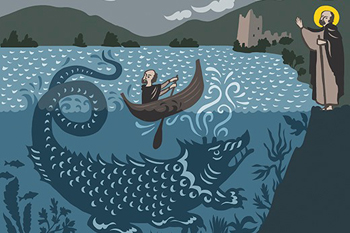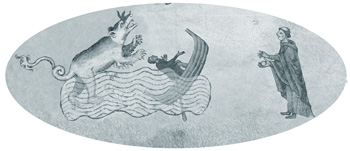Stories & Legends
 |
 |
 |
 |
 |
 |
 |
St. Columba & the Loch Ness Monster
The venerable man St. Columba was living for some days in the Province of the Picts. On one occasion in the year 565, he was obliged to cross the lake Ness, today known as the Loch Ness.
And when he reached the bank of the lake, he saw some of the inhabitants burying an unfortunate man. The Saint inquired what had happened.
 According to the account of those who were burying him, only a short time before that unfortunate man had been seized as he was swimming, and mangled most severely, by a monster that lived in the water. His wretched body was drawn away from the beast by a hook cast out by those who came to his assistance in a boat. However, it was too late, and the man died.
According to the account of those who were burying him, only a short time before that unfortunate man had been seized as he was swimming, and mangled most severely, by a monster that lived in the water. His wretched body was drawn away from the beast by a hook cast out by those who came to his assistance in a boat. However, it was too late, and the man died.
The blessed Saint, on hearing this, was far from being dismayed. Instead he directed one of his companion monks to swim to an inlet of the Loch a short distance away to a place where a coble was moored. Then he should row back with the fishing boat so that the Saint might cross the river in it.
Hearing the command of the excellent man, Lugne Mocumin obeyed without the least delay, ignoring every warning from the frightened inhabitants, who had gathered about the banks of the lake. Taking off all his clothes save his long tunic, he leaped into the water.
 But the monster, far from being satiated by the mouthfuls he had taken from his last victim, was only roused for more prey. It was lying at the bottom of the stream, and when the monster felt the water disturbed above by the man swimming, it suddenly rushed out.
But the monster, far from being satiated by the mouthfuls he had taken from his last victim, was only roused for more prey. It was lying at the bottom of the stream, and when the monster felt the water disturbed above by the man swimming, it suddenly rushed out.
Giving an awful roar, the Loch Ness Monster [for that is what it has come to be called] darted after him, with its mouth wide open, as the man reached the middle of the river stream.
Then St. Columba, observing this, raised his holy hand, while all the rest, his own monks as well as strangers, were stupefied with terror. Invoking the name of God, the Saint formed the saving Sign of the Cross in the air and gave this command to the ferocious monster: "Thou shalt go no further, nor touch the man. Go back with all speed."
At the voice of the Saint, the monster was terrified and fled more quickly than if it had been pulled back with ropes, even though it had just got so near to Lugne as he swam. In fact, there was not more than the length of a spear-staff between the man and the beast.
Then, the monks seeing that the monster had gone back and that their brother Lugne returned to them safe and sound in the boat he faithfully got and delivered, were struck with admiration, and gave glory to God in the blessed Saint.
 And even the barbarous heathen Picts who were present were forced by the greatness of this miracle, which they themselves had seen, to magnify the God of the Christians. And so there were many conversions worked by this miracle of the Saint.
And even the barbarous heathen Picts who were present were forced by the greatness of this miracle, which they themselves had seen, to magnify the God of the Christians. And so there were many conversions worked by this miracle of the Saint.
We know about St. Columba's encounter with the Loch Ness Monster because it was faithfully recorded by of his 7th-century biographer, St. Adamnan, in his work, The Life of Saint Columba. This is the first written account of the Loch Ness monster.
After the monster retreated on the command of St. Columba, it never harmed another man. However, there have been numerous sightings over the centuries.
This is the first recorded account of the famous Loch Ness monster. The episode was written by Admannan, ninth abbot of the Abbey of Iona founded by St. Columba.


And when he reached the bank of the lake, he saw some of the inhabitants burying an unfortunate man. The Saint inquired what had happened.

A terrifying monster in Loch Ness,
located in the Highland area of Scotland
The blessed Saint, on hearing this, was far from being dismayed. Instead he directed one of his companion monks to swim to an inlet of the Loch a short distance away to a place where a coble was moored. Then he should row back with the fishing boat so that the Saint might cross the river in it.
Hearing the command of the excellent man, Lugne Mocumin obeyed without the least delay, ignoring every warning from the frightened inhabitants, who had gathered about the banks of the lake. Taking off all his clothes save his long tunic, he leaped into the water.

St. Columba commands the Ness monster to retreat
Giving an awful roar, the Loch Ness Monster [for that is what it has come to be called] darted after him, with its mouth wide open, as the man reached the middle of the river stream.
Then St. Columba, observing this, raised his holy hand, while all the rest, his own monks as well as strangers, were stupefied with terror. Invoking the name of God, the Saint formed the saving Sign of the Cross in the air and gave this command to the ferocious monster: "Thou shalt go no further, nor touch the man. Go back with all speed."
At the voice of the Saint, the monster was terrified and fled more quickly than if it had been pulled back with ropes, even though it had just got so near to Lugne as he swam. In fact, there was not more than the length of a spear-staff between the man and the beast.
Then, the monks seeing that the monster had gone back and that their brother Lugne returned to them safe and sound in the boat he faithfully got and delivered, were struck with admiration, and gave glory to God in the blessed Saint.

A 1934 photo of the Loch Ness
We know about St. Columba's encounter with the Loch Ness Monster because it was faithfully recorded by of his 7th-century biographer, St. Adamnan, in his work, The Life of Saint Columba. This is the first written account of the Loch Ness monster.
After the monster retreated on the command of St. Columba, it never harmed another man. However, there have been numerous sightings over the centuries.
This is the first recorded account of the famous Loch Ness monster. The episode was written by Admannan, ninth abbot of the Abbey of Iona founded by St. Columba.

A 12-century manuscript found in the British Library
depicting the scene
of the monk saved by the Saint

Life of Saint Columba, Founder of Iona Monastery,
Written by Adamnan, 9th Abbot, ed. William Reeves,
Edinburgh: Edmonston and Douglas, 1874, chap 28.
Posted June 26, 2021
Written by Adamnan, 9th Abbot, ed. William Reeves,
Edinburgh: Edmonston and Douglas, 1874, chap 28.
Posted June 26, 2021





